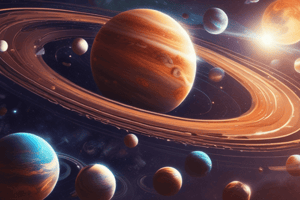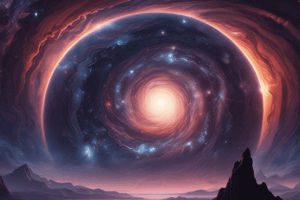Podcast
Questions and Answers
What is the approximate diameter of the observable Universe?
What is the approximate diameter of the observable Universe?
- 14 billion light-years
- 28 billion light-years (correct)
- 14 trillion light-years
- 28 trillion light-years
Which of the following best defines a galaxy?
Which of the following best defines a galaxy?
- A small collection of planets and asteroids orbiting a dwarf star.
- A single star system with planets and comets.
- A cluster of solar systems within a planetary nebula.
- A gravitationally bound system of gas, dust, and billions of stars. (correct)
The Milky Way galaxy is part of which galactic group?
The Milky Way galaxy is part of which galactic group?
- Andromeda Supercluster
- Local Group (correct)
- Great Attractor
- Virgo Cluster
Which of these shapes is NOT mentioned as a typical shape for galaxies?
Which of these shapes is NOT mentioned as a typical shape for galaxies?
Which component constitutes the vast majority of the Solar System's mass?
Which component constitutes the vast majority of the Solar System's mass?
Approximately how long ago did our Solar System form?
Approximately how long ago did our Solar System form?
In which part of the Milky Way galaxy is our Solar System located?
In which part of the Milky Way galaxy is our Solar System located?
What is the primary force that holds together both solar systems and galaxies?
What is the primary force that holds together both solar systems and galaxies?
Which statement accurately describes the relationship between the Sun, the Milky Way, and the Universe?
Which statement accurately describes the relationship between the Sun, the Milky Way, and the Universe?
What does a solar system consist of?
What does a solar system consist of?
What was the Milky Way galaxy once referred to as before the discovery of other galaxies?
What was the Milky Way galaxy once referred to as before the discovery of other galaxies?
What is dark matter?
What is dark matter?
Which statement best describes the size of the Universe?
Which statement best describes the size of the Universe?
What distinguishes the Solar System, galaxy, and Universe from each other?
What distinguishes the Solar System, galaxy, and Universe from each other?
What constitutes the Universe?
What constitutes the Universe?
Flashcards
Observable Universe
Observable Universe
The part of the Universe that we can see, about 28 billion light-years across.
Galaxy
Galaxy
A massive system of stars, gas, dust, and dark matter held together by gravity.
Milky Way Galaxy
Milky Way Galaxy
The galaxy that contains our solar system, shaped like a spiral.
Andromeda Galaxy
Andromeda Galaxy
Signup and view all the flashcards
Solar System
Solar System
Signup and view all the flashcards
Dark Matter
Dark Matter
Signup and view all the flashcards
Hubble Space Telescope
Hubble Space Telescope
Signup and view all the flashcards
Universe
Universe
Signup and view all the flashcards
Milky Way
Milky Way
Signup and view all the flashcards
Bright Matter
Bright Matter
Signup and view all the flashcards
Gravity
Gravity
Signup and view all the flashcards
Expansion of the Universe
Expansion of the Universe
Signup and view all the flashcards
Study Notes
Solar System, Galaxy, and Universe
- Solar System: The Sun and everything bound to it by gravity (planets, moons, asteroids, comets, meteoroids).
- Solar System Size: Smallest of the three (Solar System, Galaxy, Universe).
- Solar System Composition: Primarily the Sun (99.8-99.9% mass). The rest includes planets, moons, comets, asteroids, and dust.
- Solar System Formation: Formedd about 4.5 billion years ago from a dense cloud of gas and dust.
- Solar System Location: Outer spiral arm of the Milky Way galaxy
- Galaxy: A large collection of gas, dust, and billions of stars and their solar systems, held together by gravity.
- Galaxy Size: Larger than the Solar System, but smaller than the Universe.
- Galaxy Composition: Gas, dust and an immense number of stars and their solar systems.
- Milky Way: The galaxy containing our solar system and Earth.
- Galaxy Shapes: Can be spiral, elliptical, or irregular in shape.
- Galaxy Neighbors: The Milky Way is part of a group of about 30 galaxies (Local Group).
- Galaxy Count: Scientists believe there are hundreds of billions of galaxies in the Universe.
- Galaxy Contents: Billions of stars, including our Sun.
- Galaxy Dark Matter: Milky Way has at least 10 times more dark matter compared to its stars and gas.
Universe
- Universe: All of space, matter, energy, time, and its contents (planets, stars, galaxies).
- Universe Size: Largest of the three; ever-expanding. Observable universe diameter: about 28 billion light years.
- Universe Composition: Contains galaxies, solar systems, everything in space and within space.
- Universe Dark Matter: A significant portion of the universe is composed of an unknown type of matter known as dark matter, contrasted to bright matter such as planets, stars, galaxies.
- Universe Observable Limit: Scientists can observe up to approximately 14 billion light-years from Earth.
- Universe Size Variation: The size of the universe is constantly changing and growing.
- Universe Structure: Contains billions, perhaps trillions, of galaxies.
Studying That Suits You
Use AI to generate personalized quizzes and flashcards to suit your learning preferences.




